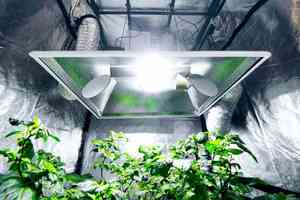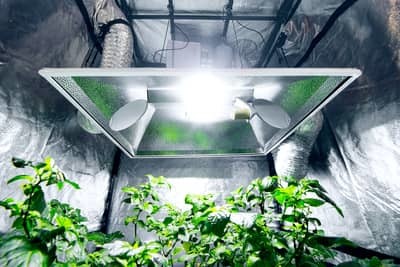As a gardener, it can be difficult to find enough sunlight for your plants to grow successfully, especially during the winter, or if you do not have a lot of natural lighting in your home. Luckily, plants can grow in artificial light as well, but is artificial light as effective as sunlight?
Generally, sunlight is best for plant growth, since artificial lights cannot replicate the specific colors of light (wavelengths) that are optimal for plants. However, artificial lights can work well to supplement sunlight, especially during winter or where sufficient sunlight is unavailable.

Why plants need light
If you’re like me, you learned about the science behind plant growth in elementary school.
But you probably didn’t retain most of it.
I didn’t realize that all those lessons would come in handy now that I love planting so much!
As a gardener, you know that plants need water, light, and soil to thrive.
Oh, if you’re curious, you can find out whether plants can grow without sunlight.
But what does light actually do for plants?
I won’t throw a long science lesson at you today.
But here’s a little refresher so we can all remember why light is so important for plant growth.
Sunlight is a part of the process of photosynthesis, which is essentially how plants get the nutrients they need in order to grow.
Chlorophyll, which is in the plants’ leaves, absorbs the light, allowing the plants to break it down and use the different components to create sugars.
They feed on the sugars, and those sugars help them to grow, just as our food does for us.
Now that we’re all up to speed on the importance of light, we can look more closely at natural light versus artificial light.
You might also want to check out our full article on how the color of light affects plant growth.
Natural light: benefits and drawbacks
Overall, the more natural light you can give your plants, the better.
Sunlight benefits plants significantly because it has all the energy plants need to create food for themselves.
And, sunlight also provides light across the full light spectrum.
This allows the plants to absorb the parts of the light that are most helpful to them (red and blue, if you’re curious).
Another potentially overlooked benefit of natural light is that it’s free!
Just using what’s available to you rather than having to buy lighting materials is great when it is possible.
The main drawback of natural light is just that: it is not always possible to use it.
Especially in the winter as the days get shorter, there’s less sunlight available
You’ll likely not be able to rely on pure sunlight to keep your plants thriving.
Further, your home may just not get a lot of natural light even in the warmer months.
This explains why I continuously failed to keep succulents alive when I lived in a basement apartment.
Sometimes you can’t find enough natural light for your plants.
Luckily, artificial lighting can help!

Artificial light: benefits and drawbacks
Let’s dive in & see the pros & cons to using artificial lights:
Pros
The main benefit of artificial light is that it works all year long!
Your artificial lighting won’t change as the seasons change—it’ll always be there for your plants and help them grow.
Using artificial lighting also means that you have more options for where to put your plants.
If you’re always looking for the natural light, you may have limited spots where your plants will grow best depending on how much sunlight your home gets.
With artificial lighting, you can place your plants wherever you want them!
Lastly, artificial light gives you more control of the growing process in general.
Also, you might want to find out whether plants can actually grow with artificial light.
You have the ability to control the amount and strength of the light your plants get, which means that you can grow plants that need different amounts of light.
You can adjust the lighting depending on the type of plant and that way each plant gets what it needs.
This is especially beneficial in relation to natural light.
If you can see that your plant is struggling and you are using artificial light, you can give it more light or take some of it away depending on what the plant needs.
Obviously that’s not possible with sunlight!
Cons
Unfortunately, natural light is not as beneficial to plants as natural light is.
As of now, there is not a light powerful enough to provide as much energy to plants as the sun can.
It’s therefore not as effective for plant growth.
It will also cost you.
There is of course the cost of actually purchasing lights and bulbs and replacing the bulbs when necessary.
But artificial lights also use your electrical energy and may affect your utility bill.
That all being said, artificial light is a great option and well worth the cost when it helps keep your plants thriving!
Different types of artificial light for plants
Okay, so you’ve decided it’s time to invest in some lighting for your plants. There are so many different options—how do you choose?
The kind of light you’ll use will depend on the types of plants you’re growing.
Different plants need different amounts and intensities of light.
Here are some examples of plants categorized by the amount of light with which they thrive:
| Light level | Plants |
|---|---|
| Low light / part-shade | Lettuce, spinach, greens, microgreens Herbs Ivy, bamboo, spider plant, snake plant Orchids, African violet, begonia |
| High light / full sun | Many flowering plants & vegetables Tomatoes, cucumbers, peppers aloe, cacti, succulents |
Different plants tend to prefer different kinds of grow lights:
- low-light plants: LED’s
- medium-light plants: fluorescent bulbs or halides can work well.
Another lighting solution will be using both fluorescent and incandescent bulbs at a ratio of 2 fluorescent to 1 incandescent.
This is because fluorescent bulbs emit cool blue light from the light spectrum, and incandescent bulbs emit warm red light.
Plants need both of these parts of the light spectrum to grow.
You can also just use fluorescent bulbs for low- and medium-light plants.
You’ll want to make sure that your bulbs are labeled either “full spectrum” or that you have both “cool white” and “warm white” bulbs.
These bulbs will provide both the blue and red light plants need.
You can also buy horticultural grow lights, which are specifically made for growing plants using artificial lighting.
These will definitely serve your purpose, but many gardeners have found that fluorescent bulbs work just as well and are more cost-effective, so it’s up to you!
Plants that need a lot of light (such as succulents and cacti) unfortunately won’t grow particularly well with only artificial light because they thrive in environments with tons of sunshine.
So if you’re using purely artificial lighting for your plants, you’ll want to select low- and medium-light plants if possible.
Combining natural light and artificial light
The best way to give your plants the light they need, especially when you don’t have access to a lot of natural light, is to use the sunlight you do have and supplement that with artificial light.
Although using artificial light allows you to place your plants wherever you would like, it’s best if you put them in a place that does get natural light.
Even if it isn’t a lot, your plants will thank you for providing them with the most natural light possible! From here, you can supplement with artificial light.
Plants need between 12 and 18 hours of sunlight per day, and knowing this will allow you to figure out how much artificial light your plants need.
When using artificial light, you will want to aim the light directly at the plant.
Fluorescent bulbs are low-heat so they can be close to the plants, but incandescent bulbs produce a fair amount of heat.
So, you’ll want to give the plants some physical space from the light if you’re using incandescent bulbs (at least a foot of space).
For extra light, you can place a mirror underneath your pots.
The mirror will reflect the light back up to the leaves of the plants and allow them to absorb even more light.

Related Questions
What light brightness is best for plant growth?
Bulb wattage is actually not a significant factor in plant growth. More important than wattage is providing both blue and red light that plants love so much.
Also more important than wattage will be the positioning of the bulb, which should be 6-12 inches from the tip of the plant.
Do plants grow better inside or outside?
There’s not a straightforward answer to this question, since it depends on the plant type & growing conditions.
In general, some plants thrive better indoors and some thrive better outdoors, but by using the lighting tips above, you can create great living conditions for plants indoors.
Do plants need darkness?
Yes, plants do need darkness. While light is necessary for photosynthesis, research shows that dark cycles help plants prepare for the following day.
Also, some plants require periods of darkness to initiate flowering.

